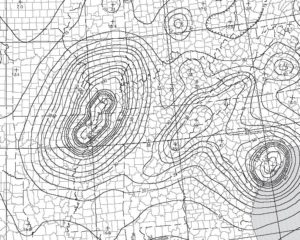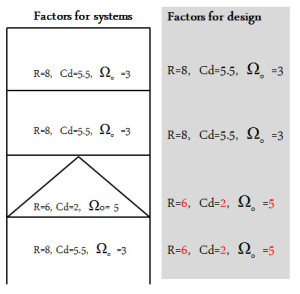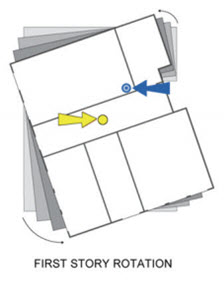The transition from one building code to the next always begs the question, “how is the newer code different?” There are several changes between the 2009 IBC and 2012 IBC that will change the way designers approach seismic design. This blog post is a broad overview of some of the changes. Since it’s not practical to cover all the changes between the previous and new codes in detail in one post, the discussion will be mainly on 2012 IBC and the corresponding ASCE7-10 reference standard.

The seismic ground motion maps have been updated to match ASCE7-10. The titles of the maps in IBC were revised from “Maximum Considered Earthquake Ground Motion” to “Risk-Targeted Maximum Considered Earthquake (MCER) Ground Motion Response Accelerations” in order to reflect the titles in 2009 NEHRP and ASCE 7-10. As in previous editions, some areas will prove difficult to read due to the contour lines, so the USGS site and GPS coordinates are recommended (http://earthquake.usgs.gov). Additional information about changes made for 2009 NEHRP is available at www.nibs.org or www.bssconline.org.
The term “occupancy category” was replaced with “risk category” in the 2012 IBC for consistency with the term used in ASCE 7-10. This change was made because it was decided that the use of the word “occupancy” implied the category was directly tied to occupancy classifications in the code, while the word “risk” more accurately communicates that the category is based on acceptable risk of failure.
 ASCE7-10 revised the way designers use the corresponding Drift amplification, Cd, and Overstrength factor, Ωo, of the Response modification factor, R. In ASCE7-05, when there is a vertical combination of different R-values, the Cd, and Ωo cannot decrease as you go down each level of a building. In ASCE7-10 (12.2.3.1), the Cd and Ωo always correspond to the R-Value as you go down. The adjacent figure illustrates the new provision to use the corresponding Cd, and Ωo with the R-value at each level.
ASCE7-10 revised the way designers use the corresponding Drift amplification, Cd, and Overstrength factor, Ωo, of the Response modification factor, R. In ASCE7-05, when there is a vertical combination of different R-values, the Cd, and Ωo cannot decrease as you go down each level of a building. In ASCE7-10 (12.2.3.1), the Cd and Ωo always correspond to the R-Value as you go down. The adjacent figure illustrates the new provision to use the corresponding Cd, and Ωo with the R-value at each level.
ASCE7-10 (12.3.4.1) added a clarification for out-of-plane anchorage forces where the redundancy factor, p = 1.0. The intent of the redundancy factor was to ensure the vertical seismic-resisting system with insufficient redundancy had adequate strength. The design forces for out-of-plane wall loading are not redundancy requirements. ASCE7-10 (12.11.12) revised the out-of-plane wall anchorage force equation where the anchorage forces are reduced for shorter diaphragm spans.
 Light-frame construction structures are no longer exempt from amplification of accidental torsion in ASCE7-10 (12.8.4.3). There are many structures vulnerable to torsional effects including some “tuck under” parking buildings that are often light-frame structures. See posts titled Soft-Story Retrofits and City of San Francisco Implements Soft-Story Retrofit Ordinance for more discussion of soft-story, light-frame buildings.
Light-frame construction structures are no longer exempt from amplification of accidental torsion in ASCE7-10 (12.8.4.3). There are many structures vulnerable to torsional effects including some “tuck under” parking buildings that are often light-frame structures. See posts titled Soft-Story Retrofits and City of San Francisco Implements Soft-Story Retrofit Ordinance for more discussion of soft-story, light-frame buildings.
This is just a brief summary of changes related to seismic design found in the 2012 IBC. What are other changes that will modify your approach to seismic design?




There is a kind of interesting issue with the 2012 IBC relating to ASCE 7 Chapter 13 and ACI 318-11 Appendix D.
First of all, 2012 IBC Sections 1905.1.9 and 1905.1.10 make no sense with regard to ACI 318-11. It is clear that IBC was modifying ACI 318-08 without knowing the changes that were coming in ACI 318-11.
Ignoring those two sections of 2012 IBC, ACI 318-11 Section D.3.3.4.3 (tension) often results in a default to Section D.3.3.4.3 (d) as (a) through (c) are often difficult to impossible to achieve (yielding in anchor bolt before concrete failure, ductile yielding in the attachment, maximum tension that can be delivered to the system). Similarly for shear, D.3.3.5.3 often default to (c). Both Sections D.3.3.4.3 (d) and D.3.3.5.3 (c) require the use of Omega not instead of the previous edition’s “0.4” factor. For ASCE 7 Chapter 13 systems, Omega not (the overstrength factor) is not given. This poses an interesting challenge as to what overstrength factor should be used. One suggestion would be 1/0.4 = 2.5 to match what was used in the previous edition. I’m interested to hear any other ideas as well.
S.K. Gosh wrote an article for the Building Safety Journal that addresses the issue of inconsistencies between the 2012 IBC and references to ACI 318-11.
http://www.skghoshassociates.com/sk_publication/Ghosh_article_Feb_BSJ.pdf
ASCE7-10 Supplement 1 now provides omega factors for Chapter 13.
http://www.asce.org/sei/Content.aspx?id=23622324314
http://ascelibrary.org/doi/pdf/10.1061/9780784410851.sup1
It is my understanding that IBC doesn’t issue errata or revisions, so we are stuck with however code officials decide to deal with the inconsistencies between 2012 IBC and ACI 318-11. I’m kind of holding my breath, hoping that ACI 318 committee doesn’t make any changes that affect the modifications in the 2015 IBC between the public draft and the final publication of ACI 318-14 or we could have this all over again. Fortunately, the 2015 IBC and ACI 318-14 public draft were well coordinated.
Thanks for pointing out ASCE 7-10 Supplement 1, that helps a lot.
The modification to appendix D of ACI 318 is based on the
2008 version of provision. Section D.4.2.2 of ACI 318-08 allowed determination
of the concrete breakout strength in both tension (Section D5.2) and shear
(section D6.2) to be determined according to the referenced sections that are
based on the concrete capacity Design Method. Based on the range of original
test data, it restricted the use of this approach for anchorage exceeding 2
inches (51 mm) in Diameter or with a depth of embedment greater than 25 inches
(635 mm).
Because there was
evidence that the predicted concrete breakout strength for anchors in tension
as given in section D5.2 by equation D-7 could be safely extended to anchors
with embedment depths exceeding 25 Inches (635 mm), the modified text allowed
this approach, provided the less conservative prediction of concrete breakout
strength in tension given by Equation
D-8 was not used.
There was also
evidence that the breakout strength procedure in Section D.6.2 was not suitable
for very large Diameter anchors loaded in shear towards a free edge. Where larger
anchor diameters were used and where concrete edge breakout would otherwise
control the anchor strength, the modified text recognizes the use of anchor
reinforcement in accordance with Section D.6.2.9.
The modification to appendix D of ACI 318 is based on the 2008 version of provision. Section D.4.2.2 of ACI 318-08 allowed determination of the concrete breakout strength in both tension (Section D5.2) and shear
(section D6.2) to be determined according to the referenced sections that are
based on the concrete capacity Design Method. Based on the range of original test data, it restricted the use of this approach for anchorage exceeding 2 inches (51 mm) in Diameter or with a depth of embedment greater than 25 inches (635 mm).
Because there was evidence that the predicted concrete breakout strength for anchors in tension as given in section D5.2 by equation D-7 could be safely extended to anchors with embedment depths exceeding 25 Inches (635 mm), the modified text allowed this approach, provided the less conservative prediction of concrete breakout strength in tension given by Equation
D-8 was not used.
There was also evidence that the breakout strength procedure in Section D.6.2 was not suitable for very large Diameter anchors loaded in shear towards a free edge. Where larger anchor diameters were used and where concrete edge breakout would otherwise control the anchor strength, the modified text recognizes the use of anchor reinforcement in accordance with Section D.6.2.9.